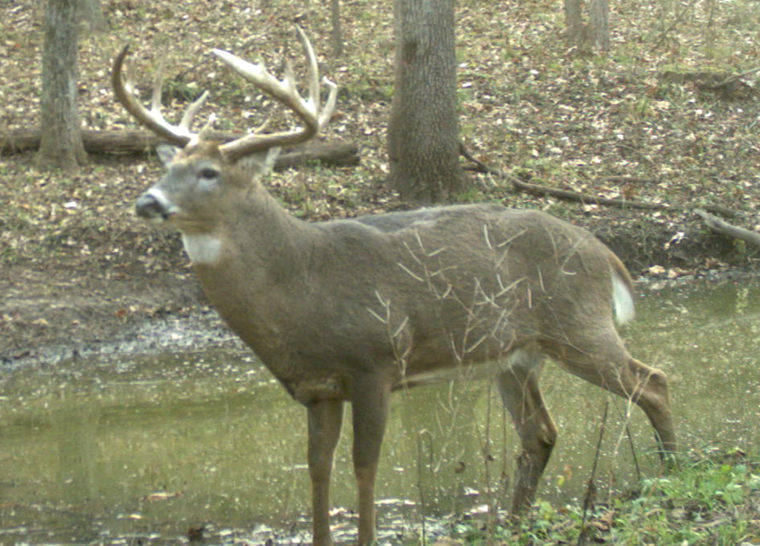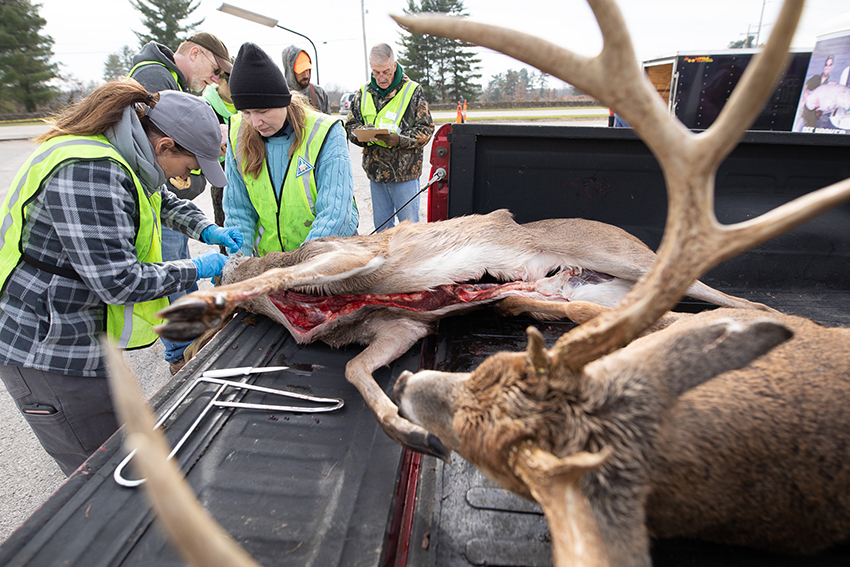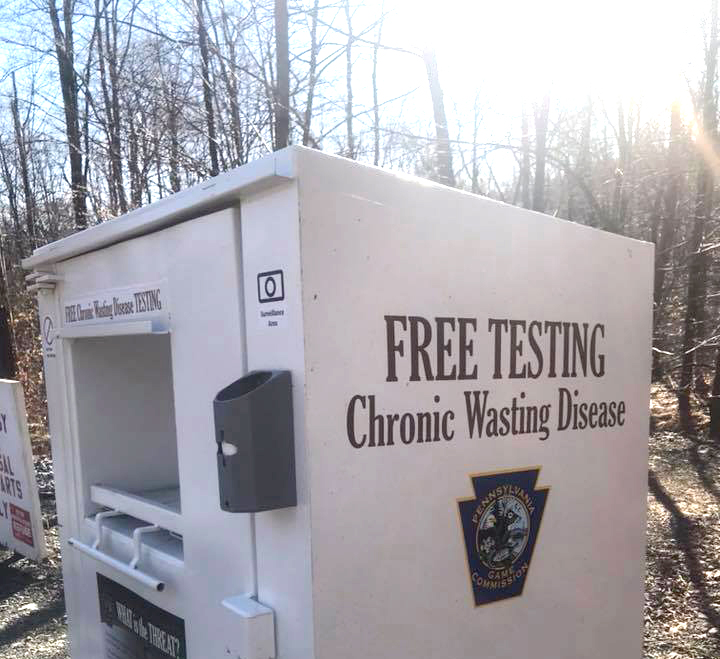Chronic wasting disease (CWD) in deer has emerged over the last 20 years as one of the most significant issues in deer hunting in modern times, with enormous biological, economic, political and cultural impacts. The fact that the disease is complex and difficult to manage has made it controversial and has caused much disagreement and debate in the hunting world. The amount of misinformation on CWD has hindered our ability to slow its spread, manage infection rates in many outbreak areas, and fight for solutions as a united community of hunters. The NDA has made it a major priority to provide hunters with reliable, science-based information that will help them engage in the fight as informed stewards of the deer resource.
As part of that effort, we’ve come to be very familiar with some of the most common questions and misunderstandings about this wildlife disease. I’ve collected them here, along with answers from the latest knowledge produced by ongoing scientific research.
What is CWD?
Chronic Wasting Disease (CWD) is an always fatal, contagious, neurological disease affecting most deer species, including elk, reindeer, moose, mule, red and white-tailed deer. It causes a characteristic spongy degeneration of the brain of infected animals, which after a long incubation of one to two years, results in emaciation, abnormal behavior, loss of bodily functions and death. Importantly, with an average incubation period of 18-24 months, most deer with CWD die from another cause before symptoms are evident to hunters.
There is currently no vaccine or cure for CWD.
What wildlife species are impacted by CWD?
CWD impacts many cervid species including white-tailed deer, mule deer, black-tailed deer, red deer, elk, moose, and reindeer.
Where does CWD occur?
As of August 2022, CWD has been identified in 30 U.S. states, five Canadian provinces (including the Toronto Zoo), Korea (from an elk imported from Canada in 1997), Norway (in free-ranging reindeer, moose and red deer), and Finland (free-ranging moose). See the USGS CWD map here.
What causes CWD?
The CWD agent is a deformed or “misfolded” prion, an abnormal form of cellular protein that is most commonly found in the central nervous system and lymphoid tissue. The abnormal prion “infects” the host animal by promoting conversion of normal cellular prion protein to the abnormal form. As a protein, the CWD agent does not contain any genetic material (DNA or RNA) like bacterial, viral, fungal, and parasitic disease agents do.
What are the clinical signs of CWD?
CWD has an 18- to 24-month incubation period, and during this period deer show few or no outward signs of the disease. However, they are still being slowly affected neurologically by the disease during the incubation period, and research has shown that CWD-positive deer are 2 to 4.5 times more likely to die of other causes than deer that are healthy. Most wild deer with the disease die from another cause such as predators, vehicle collisions and hunter harvest prior to showing any clinical signs, so most hunters will never see a wild deer with these characteristics. However, captive deer with the disease are more likely to complete the incubation period and show the classic signs of incoordination, emaciation, drooling, and loss of fear of humans.

CWD incubates in deer for 18 to 24 months before outward signs of sickness appear. This Wisconsin buck looks healthy, but it was killed by Bob Weiland shortly after Bob’s trail-cam took this photo. The buck tested positive for CWD.
What factors affect the incubation period in deer?
The incubation period is influenced by the dose of infectious materials, the route of exposure, and the genetics of the animal. However, it is ultimately 100% fatal to all deer.
Is CWD always fatal?
Yes, CWD is 100% fatal to all deer that acquire the disease.
How does CWD spread?
Contagions spread through urine, feces, saliva, blood, semen, deer parts, and especially via live deer because there is not a reliable and practical live animal test. The disease spreads through movement of infected live animals, the high-risk parts (brain, eyes, spleen, lymph nodes, backbone) of harvested animals, and natural movements of wild animals. The two most important things we can do to slow the spread are to 1) stop the transportation of live deer and 2) stop the movement of hunter-harvested deer carcasses out of CWD zones into unaffected areas.
Why am I not allowed to bait or feed in CWD zones?
Bait/feed sites artificially elevate the number of deer visiting a specific spot of land. Those deer are home to a host of potential organisms and pathogens including lice, ticks, mites, bacteria, viruses, prions and more. Many of these are shared directly with other deer at bait/feed sites while many are also left at the site and shared indirectly with deer visiting at a later time. CWD is spread directly between animals via saliva, blood, urine and feces and indirectly through environmental contamination of soil, food and water. Researchers have documented prion concentrations at bait sites in CWD-infected areas, and they’ve determined CWD is both contagious and self-sustaining in a deer herd. Unfortunately, Cornell University’s Dr. Krysten Schuler states CWD prions have been shown to remain infectious in the environment for at least two years, and Colorado Parks and Wildlife Department’s Dr. Mike Miller adds this greatly increases the disease transmission potential at bait/feed sites where saliva, urine and feces are deposited at levels much greater than other areas throughout an animal’s home range.
Should I stop using deer urine-based attractants?
The infectious materials that cause the disease are spread in urine, so some state wildlife agencies have prohibited use of natural urine. However, research shows saliva contains about 10 times the infective materials as urine. While the risk is not zero, the likelihood of transferring CWD via urine is extremely small. The National Deer Association does not oppose the use of urine-based scents based on the very low likelihood it would lead to the spread of CWD. However, we recommend only using urine-based attractants that bear the Deer Protection Program (DPP) checkmark symbol from the Responsible Hunting Scent Association (RHSA). The RHSA helps responsible hunting scent suppliers and manufacturers maintain the safety and biosecurity of urine-based scent products and their sources.
How can we prevent the spread of CWD?
The best way to prevent the spread of the disease is to prevent movement of all live deer and elk. There is no reliable and practical live animal test, and due to the long incubation period most infected animals show no signs of the disease, so they are unknowingly moved and the disease moves with them. Restricting movement of the high-risk parts (brain, eyes, spleen, lymph nodes, backbone) of harvested deer and elk is also important to reducing spread of the disease.
Does targeted removal help keep CWD prevalence rates low?
Yes, states using targeted removal are holding CWD infection rates relatively low. States that don’t use it are not. For example, Illinois has conducted targeted removal since discovering CWD in 2003 and has held infection rates in the low single digits (below 5%) ever since.
Conversely, Wisconsin ceased targeted removal over 10 years ago, and prevalence rates have climbed steadily since then to above 10% across management zones, with higher rates in many localized areas. In the worst-hit areas, infection rates among bucks now exceed 50%.
How does targeted removal help fight CWD?
Targeted removal works because experts have high success rates at removing CWD-positive deer. State and federal wildlife agency staff know where to look for them based on the locations of previous positives. Targeted removal occurs close to known CWD detections, not on a county-wide level. For example, in Missouri in 2020, the percentage of positive CWD cases among hunter-harvested samples was .09% (nine out of 10,000), while the percentage among targeted removal samples was 10 times higher at 0.9% (nine out of 1,000).
Are state wildlife agencies eradicating deer herds with targeted removal/culling operations?
No. Small numbers of deer are removed compared to hunter harvest. For example, Illinois removed 1,107 deer from 16 counties in 2020, an average of 69 deer per county, and Missouri only removed 2,399 deer from 14 CWD management zones in 2020, an average of 171 deer from each zone. However, these small removals provided big dividends by removing a higher percentage of CWD-positive deer from the landscape. Targeted removal programs are a great way to remove CWD-positive deer with the least amount of disturbance to hunters.

Because of CWD’s long incubation period, you cannot look at a deer and tell if it has the disease. If you hunt in a CWD zone, submit all your harvested deer for testing to help with disease monitoring. Here, Missouri Department of Conservation personnel collect lymph nodes from hunter-harvested deer for testing.
What does a deer with CWD look like?
The vast majority of wild deer with CWD appear completely healthy and normal. There are no visible signs of the disease until the end of the 18- to 24-month incubation period. Captive deer typically do not have to avoid predators or automobiles, so they are more likely to complete the incubation period and exhibit the clinical signs like drooling, incoordination, emaciation (wasting away), and loss of fear of humans.
Why don’t I see sick or dead deer in the woods?
Unlike hemorrhagic disease (EHD and bluetongue viruses) that has an incubation period of 5-10 days, CWD’s incubation period is 18-24 months. During the incubation period, the disease is “eating holes” in the deer’s brain, and research shows CWD-positive deer die at 2 to 4.5 times the rate of deer without CWD. Since their brain is compromised, CWD-positive deer are more prone to being eaten by predators, hit by automobiles, and harvested by hunters so they are removed from the landscape before the disease runs its full course.
Hemorrhagic disease strikes mostly in late summer due to the life cycle of the insects that spread the viruses to deer. Deer that die do so quickly and all around the same time, creating dramatic, visible impacts. CWD is not dramatic. Deer die at any time of year and of many indirect causes that mask the impact of CWD.
CWD is widespread and we still have plenty of deer to hunt. What’s the big deal?
CWD is widespread, but it currently exists at low prevalence rates in most deer herds. That means those herds can still provide hunting opportunities. But without management, prevalence rates climb slowly and steadily over time. When the prevalence rates reach approximately 27 to 30 percent, herd reduction begins and less surplus animals are available for harvest. Since there is no cure for CWD, prevalence rates continue increasing until a point that fawn production does not equal animals lost to the disease. This is why management efforts like targeted removal are so important: They work for maintaining low prevalence rates for long periods of time.
Are older bucks more likely to have CWD?
Yes, the probability of infection increases with age in bucks and does, with adult bucks being about twice as likely to be infected. You need to keep this statistic in perspective, though, as most deer populations contain a much higher percentage of adult does than bucks, so most wild deer herds have more CWD-positive does than bucks on the landscape. That means that in CWD-affected areas, we need to focus harvest pressure on does as well as bucks.

In CWD zones, adult bucks are twice as likely to have CWD as adult does. But in most hunting areas there are more does than bucks on the landscape. Harvesting and testing both is important. Photo courtesy of Missouri Department of Conservation.
Should managers focus harvest effort on bucks in CWD zones?
While the probability of infection increases with age in bucks and does, with adult bucks being about twice as likely to be infected, most deer populations contain a much higher percentage of adult does than bucks. Thus, most wild deer herds have more CWD-positive does than bucks on the landscape, so hunters in CWD zones need to focus harvest pressure on does as well as bucks.
Can humans get CWD?
There is no evidence of CWD infecting humans. However, both the Centers for Disease Control and World Health Organization recommend you avoid eating venison from a CWD-positive animal. If you hunt in a CWD zone, submit every harvested deer for testing, and wait for satisfactory results before eating the venison.
Can I eat a deer with CWD?
While there is no evidence of CWD infecting humans, both the Centers for Disease Control and World Health Organization recommend you avoid eating venison from a CWD-positive animal. If you hunt in a CWD zone, submit every harvested deer for testing, and wait for satisfactory results before eating the venison.
If I cook venison well done, does that kill CWD?
No, it does not. Prions must be heated to 1,832°F to be destroyed.
Is CWD the end of deer hunting?
No. CWD is neither harmless nor the doom of deer hunting. There is an active fight against it, and it’s up to hunters to help slow the spread and buy time for ongoing scientific research to find solutions.
What can hunters do to help slow the spread of CWD?
There is a lot hunters can do. For example, rather than ignore CWD, hunters can support active management, support legislation to fund CWD management, submit deer for testing in disease zones, follow local and state carcass transportation rules, dispose of deer carcasses appropriately, wait for test results before eating venison from disease zones, and encourage your hunting buddies to do the same.
How can I keep up with current CWD information?
The best way is to visit the National Deer Assocation’s CWD Resource Center at Chronic Wasting Disease (CWD) Resource Center – A comprehensive guide from NDA (deerassociation.com). When afield, you can search CWD zones, sample locations, carcass transportation restrictions and more on the NDA CWD layer on the onX Hunt app.
NDA’s Recommendations for Deer Hunters in CWD Areas
To answer the concerns of deer hunters in areas affected by CWD, NDA has compiled recommend practices and answers to frequently asked questions in a free document that can be downloaded and easily distributed in affected communities.
